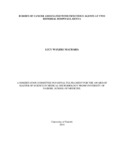| dc.description.abstract | Background: Infectious agents accounts for nearly 18% of the global cancer burden, with
higher percentages in developing countries. The commonest infectious agents associated with
cancer morbidity worldwide include, Helicobacter pylori (H. pylori) which accounts for 5.5%,
Human papilloma virus (HPV) which accounts for 5.2% of all cancers, Hepatitis B and hepatitis
C viruses which account for 4.9% of all cancers, Epstein Barr virus, Kaposi’s sarcoma associated
herpes virus, human T-lymphotropic virus 1(HTLV-1) and Human Immunodeficiency Virus.
Objective: To determine the burden of cancer at Kenyatta National Hospital and Moi Teaching
and Referral Hospital
Study method:
This study was a cross-sectional health facility-based retrospective survey conducted at Kenyatta
National Hospital and Moi Teaching and Referral Hospital for the time period 2008 to 2012.
Data was obtained from the patient’s files from the medical records department of the selected
hospitals. A pre-designed data collection form was used to collect data from patient’s files which
met the inclusion criteria. Demographic information and cancer data was extracted in relation to
age and sex. The study was approved by the KNH/U.o.N ethics and research committee.
Results:
A total of 500 files were sampled randomly in KNH and MTRH from 2008 to 2012. In KNH
60% were females and 40% were males. The age ranged from 18 to 95years with a mean of
51years. Patients between the ages of 35 years to 74 years were 76.4% with the highest age
group (55-64 years) with 22.8%. In females (n=300) the five most common cancers were
cervical 62(20.7%), breast 59(19.7%), leukemia 25(8.3%), ovary 22(7.3%) and gastric 15(5%).
In males (n=200) the five most common types of cancers were prostate 23(11.5%), laryngeal
19(9.5%), colorectal 17(8.5%), leukemia 16(8.0%) and esophageal 14(7.0%). The five prevalent
cancers associated with infectious agents in both sexes, were cervical (12.4%), gastric (5.4%),
Prostate (4.6%), nasopharyngeal carcinoma (3.4%), Non Hodgkin’s Lymphoma (2.6%) and liver
cancer (2.0%). In MTRH, 56% of the cases were females and 44% were males. Mean age was 48
years (18years to 90 years). A majority of patients (76.6%) were between 25 to 64 years. Those
aged 35 to 44 years had the highest percentage (22.8%). In females (n=300) the five most
common cancers were cervical 62(20.7%), breast 59(19.7%), leukemia 25(8.3%), ovary
22(7.3%) and gastric 15(5%). In males (n=200) the five most common types of cancers were
prostate 23(11.5%), laryngeal 19(9.5%), colorectal 17(8.5%), leukemia 16(8.0%) and esophageal
14(7.0%). The five prevalent cancers associated with infectious agents in both sexes were:
Kaposi’s sarcoma (18.6%), Cervical (8.6%), Non-Hodgkin’s Lymphoma (7.4%), Liver (3.2%)
and Gastric (3.0%).
Conclusion
This study provided data on common types and prevalence’s of cancer and demonstrated that
cancers associated with infectious agents contribute to the high burden of cancer in Kenya
although causation was not proven. Strategies to increase the use of preventive measures such as
increased awareness, vaccination, early and regular screening and treatment should be enforced
in the context of limited resources as majority of these cancers can be prevented. | en_US |
| dc.description.department | a
Department of Psychiatry, University of Nairobi, ; bDepartment of Mental Health, School of Medicine,
Moi University, Eldoret, Kenya | |

